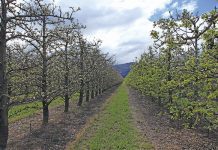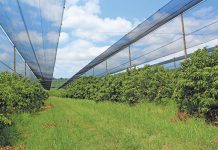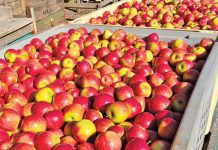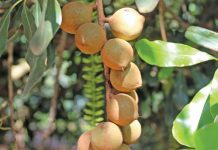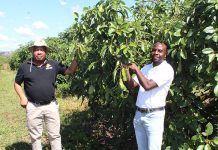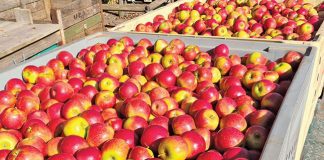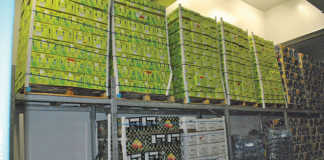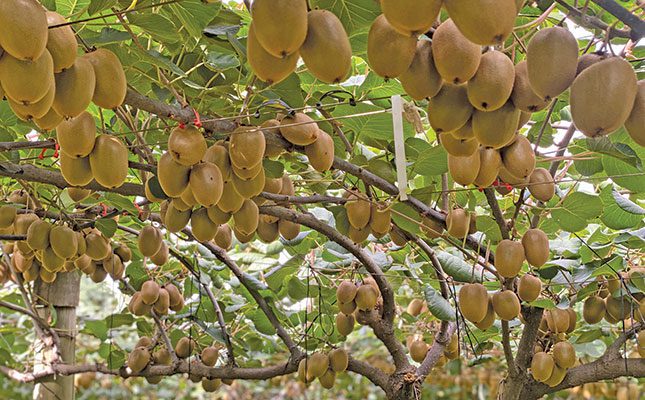
Among a sea of macadamia orchards that span the Lowveld horizon, the sight of a few small patches of hail nets is intriguing. Getting closer, one can see vines creeping upwards towards the nets and furry fruit the size of small fists hanging in clusters, and it’s exciting to realise that a new industry is in the making.
Gold Tree Farms just outside White River in Mpumalanga planted its first golden kiwifruit vines in 2014. Although South Africa’s first green kiwi orchards were planted over 40 years ago, the industry with its 320ha under production is still considered to be in its infancy.
The many kiwi varieties mean that production can be spread out across a host of different climates in South Africa. Malcolm Deacon, owner of Gold Tree Farms, for example, has 12ha of golden kiwis on the balmy White River farm and another 6ha, with partners, in a chilly part of KwaZulu-Natal. Production over two areas means that risk is spread across climates. It also gives Deacon a wider scope in evaluating what works for kiwi production in South Africa and what doesn’t.
A nursery school
When the first 6,5ha of vines were planted on Gold Tree Farms, rootstocks were not used. Deacon soon realised, however, that the roots of the vines were not equipped to handle the push for bigger production.
“In summer, kiwi plant needs to be able to grow cane for the following season and produce good-sized fruit. But without a proper ‘engine’, it can’t achieve that. We realised that the vines needed a rootstock that could provide the engine for growth.”
After a visit to New Zealand to learn from other kiwi farmers, Deacon decided on the Bruno rootstock variety, as it is used by the majority of growers there.
“The Bruno is a strong green [kiwi] variety that can carry the plant through production,” he explains.
As the rootstock was not freely available in South Africa, Deacon set up his own nursery on his farm and went on to plant all his new orchards, as well as replace the older ones, with Bruno.
The nursery proved greatly advantageous: it not only supplied the farm, but allowed Deacon to gain greater insight into cultivation practices and what it is needed for optimal production. Today, the nursery is commercialised and licensed to grow all cultivars in South Africa, and it supplies other farmers.
Gold Tree Farms’ older blocks are planted at a spacing of 4m x 2,5m, and the newer blocks at 5m x 2,5m. Deacon notes that he is still trying to find the ‘sweet spot’ when it comes to planting density. Kiwi plants start producing fruit in the third year after being planted out in the orchard.
Trial and error
Kiwifruit originated in Chinese forests, and China is still the world’s biggest producer. While plenty of information is available on growing kiwis, there is relatively little that takes into account the specific climate and conditions in South Africa. Deacon has nonetheless made much progress on local cultivation practices over the past eight years, reviewing every step during the season and tweaking systems for the next year.
He notes that it’s important to plant kiwis in areas that don’t have late frost, or have frost mitigation systems, so that growth (or worse, flower development) after winter is not lost. Kiwis also require high summer humidity.
While minimum winter temperatures in White River are sufficient at around 0°C to 10°C, maximum temperatures on sunny days are sometimes too high for kiwis. Deacon has therefore installed an evaporative cooling system above the vines and below the nets, and switches it on at midday to lower the temperatures.
With a deep dormancy in winter, plant growth is considerably more vigorous in spring.
Amongst the main problems in kiwi production are Phytophthora and Pythium spp, both of which are soil-borne pathogens.
“Kiwis don’t like wet feet. If there’s excess water in the orchard and the soil doesn’t have good drainage, plants can die off completely,” explains Deacon.
Soil type and management need to be managed carefully for an even yield. Deacon says that yields on his young plantings currently vary between 10t/ha and 20t/ha depending on the soil type.
“We’re still fine-tuning our fertiliser and irrigation programme and expect the lower-performing blocks to start increasing their yield eventually.
“The sandy soil is very tricky because the nutrients leach and it’s difficult to keep moisture in. At the same time, soils that have a high clay content can be problematic because they hold too much water in the root zone.”
Last season, between 12t/ha and 18t/ha of compost was worked into the soil to improve the soil structure. Granular fertiliser is applied according the results of a soil analysis conducted at around flowering, and another towards the end of the year to ensure that fertilisation is on track.
Deacon keeps an eye on the level of magnesium . “It can show as a shortage, but we’re not sure if it’s related to what kiwis use, or if it’s a characteristic of our soil. Calcium, as with all fruit, is vital.”
Micro-irrigation is used, and Deacon is considering using drip fertigation on the sandy soils to aid nutrition retention.
“It’s thirsty, but the area plays a big role in the water requirement. In KwaZulu-Natal, we’ve irrigated twice this season, whereas in White River the irrigation runs a few times a week. The latter provides 2,5ℓ/hour, and we do two to three hours on a cycle. The number of cycles depends on the season and soil moisture, which we monitor daily. Rainfall is around 800mm/year.
“My thinking is that kiwis, being forest-dwelling plants in nature, like a thick mulch layer. Because the plants have shallow roots, it’s important to look after the ridge line so that the roots are protected.”
Gold Tree Farms’ kiwis are therefore planted on gentle ridges or mounds. This ensures that their roots are lifted slightly, the soil drains properly, and the topsoil layer is increased. The ridge is not too high, however, as workers still need to be able to reach the fruit and work in the canopy.
Managing insects
Cover crops are sown in between the rows, with a specific focus on those that help control one of the most important pests of kiwifruit: nematodes.
“It’ll take time to reduce the populations in the soil, but we hope it’ll prove successful so that we can manage pests naturally. Once nematodes have taken hold of the roots, fruit size decreases. Eventually, infected vines become unproductive, so it can really play havoc with the orchard.”
Other pests to watch out for are fruit flies and small, as-yet-unidentified worms that sit between the clusters of fruit, scratching the skin.
The addition of white clover as a cover crop has proved particularly successful, as its flowers lure bees into the orchard, where they make their way to the kiwi flowers. Pollination is essential for fruit production, particularly in terms of size, and there are several factors to consider.
“There are two kinds of structures in which to plant kiwis to get optimal pollination. The ‘strip male’ method has a female row that contains just fruit-bearing plants, and then a row with only males. Only every second row produces fruit.
“Then there’s an opposing female set-up where every line has females, with males running across the profile. New Zealand seems to prefer the strip male set-up with plant spacing across the orchard at 3,5m x 2,5m. In South Africa, it looks as if the industry is moving towards an opposing female set-up. But there are still many questions about the best way forward and more research is required.”
Bees are used for pollination, and around four to six hives per hectare are required. Artificial pollen is nonetheless required to supplement the natural pollen. The artificial pollen is imported from the US and flowers are pollinated by hand. It is labour-intensive, but necessary for achieving good-sized fruit, as pollination is the most crucial factor in producing a good crop, says Deacon.
In White River, the kiwis flower during the last week of September.
Let there be light
Another crucial contributor to good fruit set is adequate light in the orchard. The canopy needs to be managed carefully to allow for just enough light, but not too much. A practice called zero-leafing is followed, where certain leaves and new shoots alongside fruit are removed so that foliage doesn’t grow and cast shade over the fruit.
Deacon explains that the process of canopy management starts in winter when he removes all the fruiting wood from the previous season and sets up the vines by ensuring the new canes are spaced correctly across the trellises.
“The cane grows rapidly and needs to be pruned. We don’t want double the amount of replacement cane because it has a negative impact on overall production. Canopy management is finicky, but very important to get right.
“If you’re really on top of your game, you’ll be able to count all your buds in spring, get a flower-to-bud ratio prediction for summer, and then estimate your yield. You can then work with your inputs to ensure that the nutrition the orchards receive is sufficient to feed the crop optimally.”
Netting structures are required to protect the crop against hail. Deacon notes that the colour of the net does not appear to influence the crop.
Harvest
Being brown, the skin of the kiwifruit cannot be used to gauge ripeness. The internal flesh is therefore tested regularly during the harvest window to find the optimal time for picking. Samples are taken and tested for Brix level, dry matter, and pressure.
The fruit is usually harvested from the middle to the end of February, and Gold Tree Farms requires an additional 15 seasonal workers to pick the 12ha of fruit. Deacon and two other local kiwi growers use the services of an avocado packhouse to pack their crop.
“The equipment is suitable for kiwis and the packhouse has cold storage capacity. Kiwis are also packed when the packhouse is relatively quiet, so the arrangement works well. The fruit is packaged and sold under the Oscar Gold brand, with 80% being exported, mostly to Europe.”
The shelf life of kiwifruit is three to four months, so sea freight is suitable. Gold Tree Farms’ export fruit is sent to the Port of Cape Town.
Room for growth
Kiwifruit is still relatively unknown in South Africa, and golden kiwis especially so. Deacon believes that while focusing solely on the local market is not currently feasible, there is room for growth should more marketing be done to educate local consumers about golden kiwis.
“Internationally, demand is good and can sustain increased production in South Africa. But we face competition from other countries and need to develop a name for South Africa as a supplier of quality kiwifruit.”
Prospective growers should be prepared to pay their share of ‘school fees’, however, he cautions.
“The industry is still very young and although information is available internationally about production practices, it takes time to see what works on a farm and what doesn’t. Even within South Africa, there are differences between the winter rainfall and summer rainfall growing areas. What works in the Western Cape won’t necessarily work here. There are also differences between cultivars.
“Unfortunately, the learning curve is long and expensive. You need to go through a season and then take the lessons and apply them in the next season. But we have the benefit of good local and overseas networks, with people who understand soil as well as marketing and cold chain management, so we’re steadily getting there.”
Deacon is optimistic about the future of kiwi production. “I think we can produce high-quality golden kiwifruit. We have a good marketing structure with our French partner, Primland, and can start our season’s supply to the world when there’s a relatively low volume of gold kiwis on the market. We plan on growing, splitting risk across different climates and supply timings, so that we can build a constant supply of fruit to better link in with our customers.”
Email Malcolm Deacon at [email protected].


